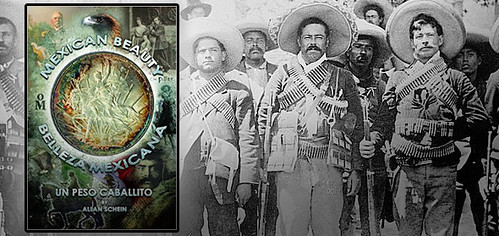
PREV ARTICLE
NEXT ARTICLE
FULL ISSUE
PREV FULL ISSUE
BOOK REVIEW: MEXICAN BEAUTY: UN PESO CABALLITO
Charles Morgan and Hubert Walker published a review of Mexican Beauty: Un Peso Caballito by Allan Schein onCoinWeek this
week. Here's an excerpt. -Editor

Schein makes no bones about it: the Caballito is by far his favorite coin. The design was born in Beaux-Arts-era France, surreptitiously “improved-upon” by U.S. Mint Chief Engraver Charles Barber, and struck during five of the most turbulent years in modern Mexican history – years that saw the overthrow of Mexican President Porfirio Díaz, a descent into revolutionary chaos, the assassination of Díaz’s rival and successor Francisco Madero and the infamous rise of El Chacal, Victoriano Huerta. How does the Chinese curse go, “may you live in interesting times”? The coin itself was adapted from a 50-Centavo pattern from 1907 designed on commission by French engraver Charles Pillet (1869-1960). It’s a striking design, evoking the spirit of national independence. The reverse (often confused for the obverse) features a partially-clothed female riding side-saddle (for the sake of modesty, we presume) atop a majestic horse, its hooves unshod, its disposition wild and bucking. In the figure’s right hand, according to Schein, is a forked branch from an Encino Oak. In her left hand a torch, held high. Behind the horse and its rider are the beaming rays of the sun (something French commander Charles de Lorencez probably wishes he saw more of before facing Ignacio Zaragoza at Puebla). The obverse provokes discussion as well. A proud eagle sits atop a cactus, atop an earthen mound, a snake in the grip of its beak and talon. For generations, Schein says, numismatists have argued about the identity of the bird. Some suggest the bird is a Caracara – a slow-flying scavenger. For Schein, there’s little doubt that the bird is in fact a Golden Eagle. Readers of the book will enjoy the lengths that Schein goes to in order to buttress his position. One doesn’t need to be an ornithologist, however, to appreciate the sculptural beauty of the design. Fans of the Beaux-Arts style of design and architecture will enjoy seeing the Cabalitto in the context of its designer’s larger body of work. The book is as much a “first course” in the study of the Mexican one-peso coin of 1910-1914 as it is a primer in the work of the man whose hands and chisel created it. It’s a solid and worthwhile effort on a worthy topic, written in English with a side-by-side Spanish translation provided by Roberto del Bosque, a coin dealer from the firm Mexican Coins and More of Brownsville, Texas. For a self-published work, interested readers will find no fault in the quality of the presentation. Coin photographs are clear and in full-color. Archival photographs of important historical figures and other key works of the engraver are presented, and sections devoted to variety attribution and grading effectively convey the intended information. Mexican Beauty: Un Peso Caballito
To read the complete article, see:
Wayne Homren, Editor The Numismatic Bibliomania Society is a non-profit organization promoting numismatic literature. See our web site at coinbooks.org. To submit items for publication in The E-Sylum, write to the Editor at this address: whomren@gmail.com To subscribe go to: https://my.binhost.com/lists/listinfo/esylum All Rights Reserved. NBS Home Page Contact the NBS webmaster 
|